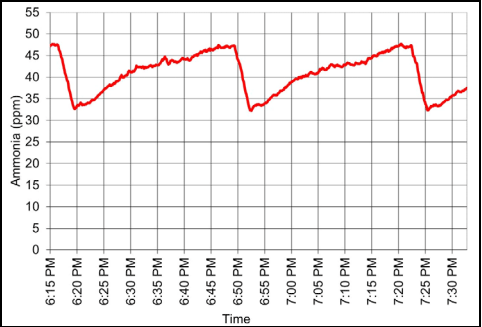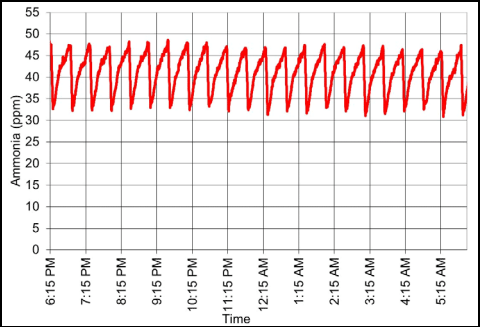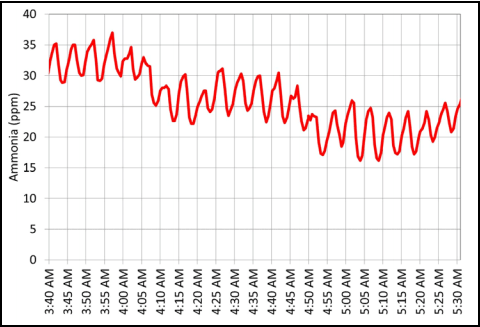Ammonia Concentration Vs. Ventilation Rate
Published: December 31, 2014
By: Dr. Mike Czarick and Dr. Brian D. Fairchild (University of Georgia)
One of the biggest challenges with maintaining optimal air quality during cold weather is the fact that much of what we are trying to control is constantly being generated. For instance, if we had an empty house and filled it with smoke we could turn on a few exhaust fans and within minutes the smoke would be gone - problem solved. But, when it comes to gasses such as ammonia and carbon dioxide which are constantly being generated, it is a never-ending process to keep them under control. For example, during the minimum ventilation, “off cycle” ammonia levels will slowly rise as the ammonia produced by the litter builds. When the minimum ventilation fans turn on the ammonia levels will quickly decrease as fresh air is added to the house. But as soon as the exhaust fans turn off, the ammonia level will start to rise again and by the end of the “off cycle” it will be back to where it was prior to the fans turning on.
Figure 1. Ammonia concentrations in broiler house between flocks

The cyclic nature of ammonia concentrations in poultry houses can an be seen in Figure 1 where between flocks two 48" fans were operating three minutes out of every 30 to help limit the buildup of ammonia and moisture. Though operating the exhaust fans lowered the concentration of ammonia in the air by approximately 15 PPM, as soon as the fans turned off ammonia concentration started to rise, and within 30 minutes it was back to what it was before the exhaust fans turned on. The pattern continued for the next 14 hours of the study (Figure 2). Little if any progress was made in lowering the overall average ammonia concentration.
Figure 2. Ammonia concentrations in between flocks (14 hours)

The same cyclic pattern of ammonia concentrations can be seen in Figure 3 where minimum ventilation fans were operating 90 seconds out of five minutes in a house with three-week-old birds. Minimum fan operation decreased ammonia levels by approximately 7 PPM, but by the end of the minimum ventilation fan “off cycle” they rose the same 7 PPM. The average ammonia concentration remained essentially the same, 33 PPM, over the course of the night.
Figure 3. Ammonia concentration in broiler house with three-week-old birds

For any minimum ventilation fan setting the ammonia levels will tend to reach a level of equilibrium. In Figures 1, 2, and 3, though the minimum ventilation fans reduced ammonia concentrations quickly, the reduction was temporary and over the short term average ammonia levels did not significantly change. The equilibrium ammonia concentration can of course be lowered by increasing the minimum ventilation rate. An important fact to keep in mind is that the reduction in the equilibrium or “average” ammonia concentration will be roughly proportional to the change in exhaust fan runtime. This means that in order to make large changes in average ammonia concentrations, relatively large changes in minimum ventilation fan runtime need to be made. For instance, the minimum ventilation fan runtime in the house illustrated in Figure 3 was increased from 90 seconds to 120 seconds out of five minutes (4:00 am). The increase in fan runtime of 25% reducedFigure 4. Increasing minimum ventilation fan runtime from 90 to 120 seconds out of five minutes (4:05 am) Figure 5. Increasing minimum ventilation fan runtime from 90, to 120 (4:05 am), then to 150 seconds out of five minutes (4:50 am) average ammonia concentration by 22% (from 33 to 27 PPM) (Figure 4). Increasing fan runtime from 90 to 150 seconds, a 40% increase, reduced ammonia concentration by 35% (from 33 PPM to 22 PPM) (Figure 5). So in short, if you want to cut your ammonia levels in half, double your minimum ventilation rate. This holds true if the ammonia concentration is 80 PPM and you want to drop it to 40 PPM or even if the ammonia concentration is 40 PPM and you want to decrease it to 20 PPM.
Figure 4. Increasing minimum ventilation fan runtime from 90 to 120 seconds out of five minutes (4:05 am)

Figure 5. Increasing minimum ventilation fan runtime from 90, to 120 (4:05 am), then to 150 seconds out of five minutes (4:50 am)

Does this mean that if you have high ammonia concentrations that you may have to double or quadruple your minimum ventilation rates indefinitely? Not necessarily. Though high minimum ventilation rates will help to keep ammonia levels to a minimum they will also tend to address the root cause of ammonia: litter moisture. Over time, higher ventilation rates will tend to reduce litter moisture levels, which in turn will reduce the ammonia generation rate, which in turn leads to lower ammonia levels and an overall reduction in the minimum ventilation rate required to keep ammonia concentrations to a reasonable level. Can this method of ammonia control prove expensive? Sure. But, the fact is that once you have an ammonia problem it is expensive to solve. The key to keeping ammonia levels and heating costs to a minimum is preventing high ammonia levels in the first place. Between flocks remove cake from the house as soon as the birds leave and ventilate the house to help dry the litter. Use a litter treatment according to manufacturer’s recommendations prior to chick placement. Most importantly closely manage house moisture levels by monitoring the relative humidity of the air in the house. The relative humidity of the air in a house is an indirect measure of litter moisture. Generally speaking, the ideal relative humidity would be approximately 50%. As the relative humidity of the air in the house climbs, so does litter moisture. Increased levels of litter moisture results in higher ammonia production rates. If you allow the average relative humidity climb to 70 to 80% you will have wet litter and high ammonia levels which can only be reduced to acceptable levels by a dramatic increase in minimum ventilation rates. To avoid this situation, make relatively small adjustments to the minimum ventilation rates on a daily basis. Record the relative humidity in your houses each morning. If you see the relative humidity climbing, make larger increases. Bottom line: don’t wait until you have an ammonia problem to try to solve it. After all, “an ounce of prevention is worth a pound of cure.”
This article was originally published at UGA Cooperative Extension Poultry Housing Tips Vol. 26 no. 7, December 2014. Engormix.com thanks the authors for this contribution.
Related topics:
Authors:
University of Georgia
University of Georgia
Recommend
Comment
Share
University of Georgia
17 de enero de 2015
Generally we are looking for a total cycle time of 300 seconds (on + off time). So if we increase the on time from 90 to 120 seconds we would decrease the off time from 210 to 180 seconds.
Recommend
Reply
Recommend
Reply
14 de enero de 2015
If we increase our runtime from 90 to 120 or 150 seconds then we use same fan running time which we use for 90 seconds or we increase it as increase the runtime...?
Recommend
Reply

Would you like to discuss another topic? Create a new post to engage with experts in the community.










.jpg&w=3840&q=75)